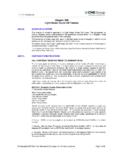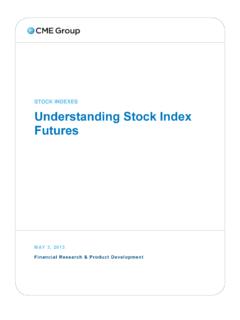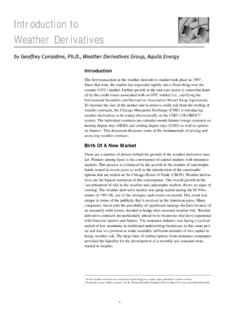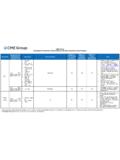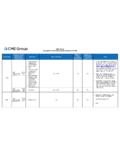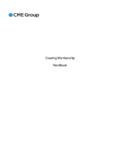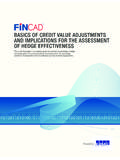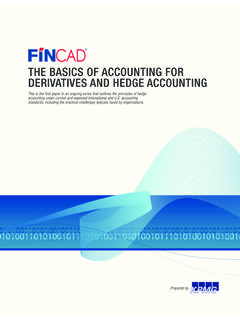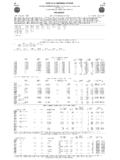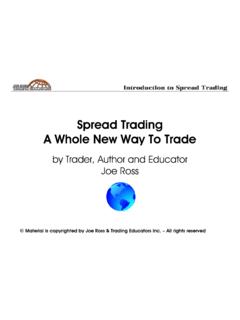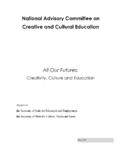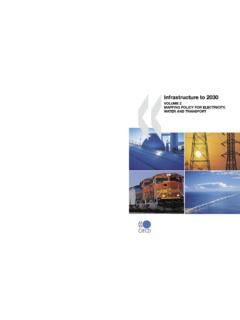Transcription of A Trader's Guide to Futures: Guide - CME Group
1 A trader s Guide to FuturesThought Leadership with a Global PerspectiveCME Group EDUCATIONHow the world trader s Guide to Futures CME Group offers the widest range of tradable products available anywhere all on a single platform: interest rates, stock indexes, currencies, agriculture, energy, metals (industrial and precious) and alternative investment products, such as weather and real estate. In more than 150 countries, our centralized global exchange delivers transparent pricing and equal access virtually around the clock. With the backing of CME Clearing, the leading derivatives clearing facility in the world, the financial integrity of our markets is unsurpassed.
2 SECTION 1 What Are Futures? 4 SECTION 2 Who Trades Futures? 6 SECTION 3 Why Trade Futures? 9 SECTION 4 How Does a Trade Work? 13 SECTION 5 How Do I Get Started? 24 SECTION 6 Futures Quiz 30 TABLE OF is your introductory Guide to trading futures. If you re a trader who is interested in branching out from equities or cash FX into futures, this Guide will provide a great starting point. If you already know something about futures trading, you can jump to any chapter for a review or to the back of the booklet and test your knowledge in our Futures Quiz. the United States, trading futures began in the mid-19th century with the establishment of central grain markets where farmers could sell their products either for immediate delivery, also called the spot or cash market, or for forward delivery.
3 These forward contracts were private contracts between buyers and sellers and became the forerunner of today s exchange-traded futures contracts. Both forward contracts and futures contracts are legal agreements to buy or sell an asset on a specific date or during a specific month. Where forward contracts are negotiated directly between a buyer and a seller and settlement terms may vary from contract to contract, a futures contract is facilitated through a futures exchange and is standardized according to quality, quantity, delivery time and place. The only remaining variable is price, which is discovered through an auction-like process that occurs on the Exchange trading floor or via CME Globex, CME Group s electronic trading platform.
4 4 What Are Futures?SECTION 15 CME Group EduCaTION | SECTIon 1 Although trading began with floor trading of traditional agricultural commodities such as grains and livestock, exchange-traded futures have expanded to include metals, energy, currencies, equity indexes and interest rate products, all of which are also traded electronically. FUTURES Standardized contracts for the purchase and sale of financial instruments or physical commodities for future delivery on a regulated commodity futures CONTRACT A private, cash-market agreement between a buyer and seller for the future delivery of a commodity, at an agreed upon price.
5 In contrast to futures contracts, forward contracts are not standardized and are MARkET A market where cash transactions for the physical or actual commodity GLOBEx The first global electronic trading system for futures and options has evolved to become the world s premier marketplace for derivatives trading. With continual enhancements, the platform has effectively enabled CME Group , already known for innovation, to transform itself into a leading high-tech, global financial derivatives Trades Futures?SECTION 2 Conventionally, traders are divided into two main categories, hedgers and speculators.
6 Hedgers use the futures market to manage price risk. Speculators on the other hand accept that risk in an attempt to profit from favorable price movement. While futures help hedgers manage their exposure to price risk, the market would not be possible without the participation of speculators. They provide the bulk of market liquidity, which allows the hedger to enter and exit the market in an efficient manner. Speculators may be full-time professional traders or individuals who occasionally trade. Some hold positions for months, while others rarely hold onto a trade more than a few seconds.
7 Regardless of their approach, each market participant plays an important role in making the futures market an efficient place to conduct business. The following pages will provide brief profiles of the most common types of market participants. When we started 21 years ago, the trading was self-contained. Over the last 15 years, it s broadened so much with electronic trading that people now have access to these markets from any place in the world. It s been interesting to see how the markets have grown and matured because of that. Jim Iuroio Broker67 CME Group EduCaTION | SECTIon 2 HedgersHedgers have a position in the underlying commodity.
8 They use futures to reduce or limit the risk associated with an adverse price change. Producers, such as farmers, often sell futures on the crops they raise to hedge against a drop in commodity prices. This makes it easier for producers to do long-term planning. Similarly, consumers such as food processing plants often buy futures to secure their input costs. This allows them to base their business planning on a fixed cost for core ingredients, such as corn and wheat. other examples include: airlines hedging fuel costs or jewelry manufacturers hedging the cost of gold and silver.
9 This makes it easier for these companies to manage price risk and stabilize the cost passed on to the end-user. Individual TradersMany speculators are individuals trading their own funds. Traditionally, individual traders have been characterized as individuals wishing to express their opinion about, or gain financial advantage from, the direction of a particular market. Electronic trading has helped to level the playing field for the individual trader by improving access to price and trade information. The speed and ease of trade execution, combined with the application of modern risk management, give the individual trader access to markets and strategies that were once reserved for ManagersA portfolio or investment manager is responsible for investing or hedging the assets of a mutual fund, exchange-traded fund or closed-end fund.
10 The portfolio manager implements the fund s investment strategy and manages the day-to-day trading. Futures markets are often used to increase or decrease the overall market exposure of a portfolio without disrupting the delicate balance of investments that may have taken a significant effort to build. What Types of Traders are There?PRODUCERSH edge against a drop in commodity against a rally in commodity Trading FirmsProprietary trading firms, also known as prop shops, profit as a direct result of their traders activity in the marketplace. These firms supply their traders with the education and capital required to execute a large number of trades per day.
